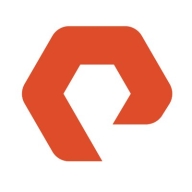


SolidFire and Dell PowerMax are two major players in the advanced storage solutions category. SolidFire appears to have the advantage for dynamic data centers due to its scalability and ease of integration, while Dell PowerMax is preferred for its high performance and enterprise capabilities.
Features: SolidFire offers granular quality of service controls, a node-based architecture allowing seamless capacity expansion, and easy integration with virtualization platforms like OpenStack. Dell PowerMax provides outstanding performance with NVMe storage, advanced deduplication, and robust replication features like SRDF, maintaining high availability.
Room for Improvement: SolidFire could improve with enhanced protocol support, simplified admin tools, and broader hardware options. Dell PowerMax, while feature-rich, could reduce complexity in setup, lower pricing, and integrate better with cloud services and AI capabilities.
Ease of Deployment and Customer Service: SolidFire users benefit from a smooth deployment process and strong support, though some face integration challenges. Dell PowerMax involves more intricate setup due to its scale, and users appreciate its highly rated support, despite requiring a more user-friendly interface.
Pricing and ROI: SolidFire requires a significant initial investment but offers cost efficiency through flexible scaling. Its ROI emerges over time with lower operational costs. Dell PowerMax, priced as a premium solution, justifies costs with superior features and delivers ROI in high-performance enterprise environments.
| Product | Market Share (%) |
|---|---|
| Dell PowerMax | 4.6% |
| Pure FlashArray X NVMe | 1.0% |
| SolidFire | 0.2% |
| Other | 94.2% |



| Company Size | Count |
|---|---|
| Small Business | 15 |
| Midsize Enterprise | 11 |
| Large Enterprise | 12 |
| Company Size | Count |
|---|---|
| Small Business | 17 |
| Midsize Enterprise | 16 |
| Large Enterprise | 54 |
| Company Size | Count |
|---|---|
| Small Business | 8 |
| Midsize Enterprise | 6 |
| Large Enterprise | 16 |
Pure Storage FlashArray//X is the world’s first enterprise-class, all-NVMe flash storage array. It represents a new class of storage – shared accelerated storage, which is a term coined by Gartner – that delivers major breakthroughs in performance, simplicity, and consolidation.
PowerMax leads in mission-critical enterprise storage with advanced architecture and AI-driven automation, ensuring secure and efficient IT optimization. Its multi-node NVMe scale-out framework delivers unmatched performance and consolidation, backed by Dell’s Future-Proof Program.
PowerMax is renowned for its robust reliability, performance, and efficient data reduction capabilities. Users benefit from its NVMe architecture, aiding significant scalability and cost efficiency through effective deduplication and compression. Unisphere simplifies management, while CloudIQ provides enhanced monitoring. With high availability and strong IOPS capabilities, PowerMax effectively manages demanding workloads and ensures seamless operations. Its compact design and increased storage capacity enhance user experience, particularly with easy maintenance and robust performance.
What are the key features of PowerMax?Dell PowerMax is predominantly employed in mission-critical applications such as SQL, Oracle databases, ERP systems, and high transactional environments. Healthcare, finance, and e-commerce sectors leverage its high performance, scalability, and NVMe technology for low latency and redundancy. It is adept in storage consolidation, data analytics, and disaster recovery.
SolidFire delivers all five core elements needed to deliver newfound storage agility to your next generation data center and beyond. With SolidFire you can deploy new applications and capabilities faster, provide more agile and scalable infrastructure, increase application performance and predictability, enable automation and end-user self-service and raise operational efficiency and reduce cost.
We monitor all All-Flash Storage reviews to prevent fraudulent reviews and keep review quality high. We do not post reviews by company employees or direct competitors. We validate each review for authenticity via cross-reference with LinkedIn, and personal follow-up with the reviewer when necessary.